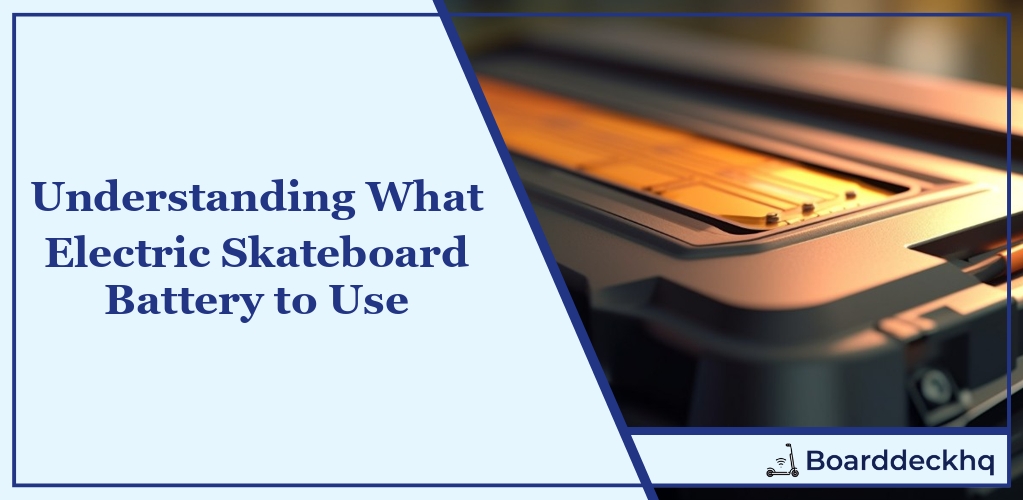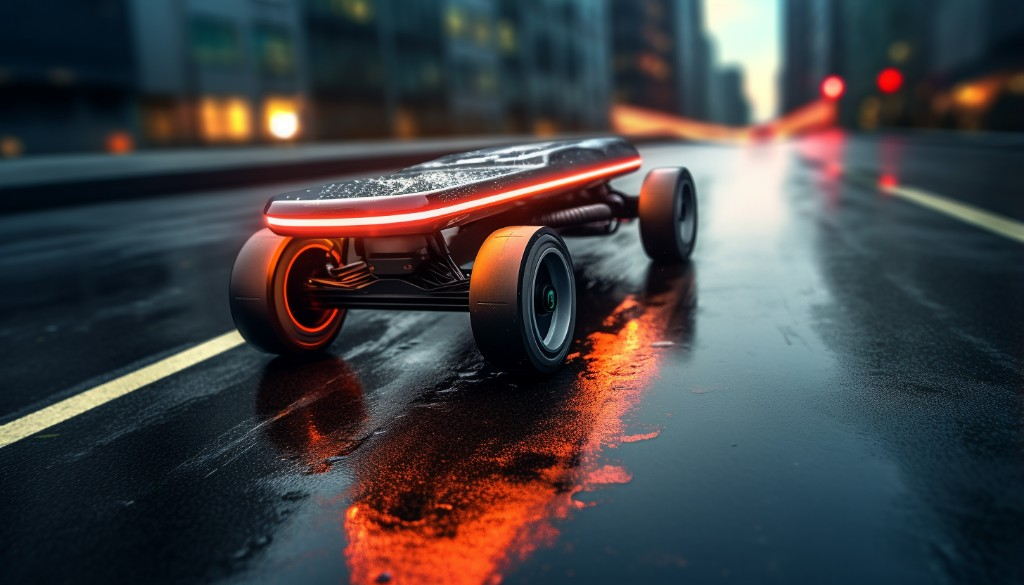Ever wondered what keeps your electric skateboard gliding smoothly on the streets? The answer lies in the heart of your ride – the battery. It’s not just about power, but also about how that power is managed and maintained. The right battery can mean the difference between a thrilling ride and a disappointing fizzle. So, are you ready to unravel the mystery behind your skateboard’s untapped potential?
What we’ll cover
- Key Battery Dynamics
- Choosing the Right Battery
- Deep Dive into Battery Types
- Tips for Extending Battery Life
- Basics of Battery Charging
- Influence of Battery Technology
- Importance of Battery Management Systems
- Custom Electric Skateboard Batteries
Let’s get rolling and power up your knowledge on electric skateboard batteries!
Essential Battery Dynamics for Electric Skateboards
We all know that the heart of any e-skateboard is its battery. The electric skateboard battery you choose can significantly affect your board’s performance, range, and overall longevity. Let’s dive deep into the different types of batteries, their specifications, and maintenance practices to help you make an informed decision.
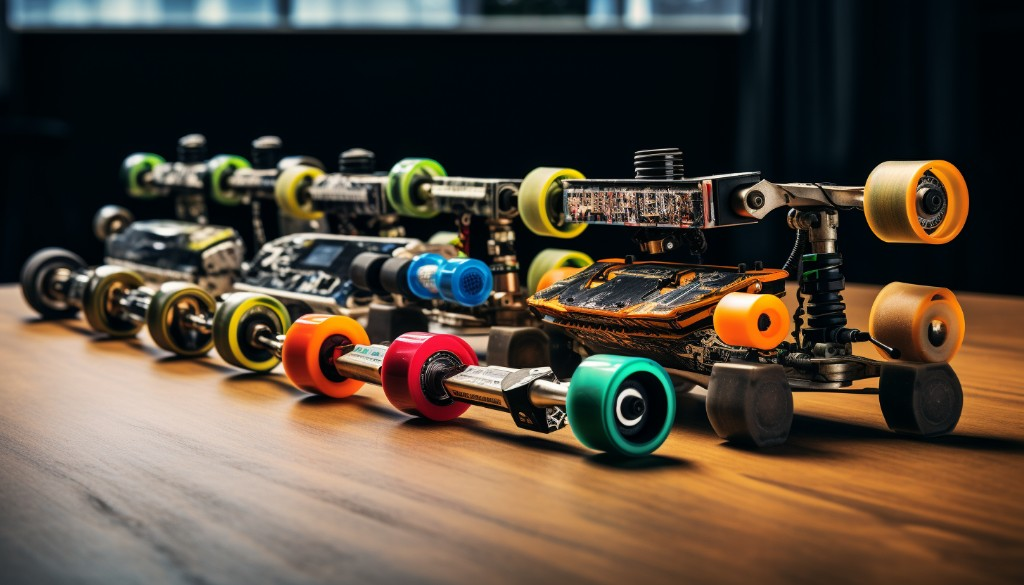
Fundamentals of Battery Types
The battery types primarily used in electric skateboards are Lithium-Ion, Lithium Polymer, and Lithium Iron Phosphate. Each has its unique characteristics and trade-offs.
Lithium-Ion Batteries
First up, let’s talk about Lithium-Ion batteries. They are the most common type of battery found in electric skateboards, thanks to their excellent energy density and long life cycle. The energy stored in these lithium-ion cells is released as electricity when a circuit is connected between the positive and negative ends of the battery. It’s this flow of electrons that powers your board.
Lithium Polymer Batteries
Next, we have Lithium Polymer batteries. These batteries are lighter than their lithium-ion counterparts and can be manufactured in a variety of shapes and sizes. They are known for their superior discharge rates, making them ideal for high-performance electric skateboards. However, they do require more careful handling due to their delicate nature.
Lithium Iron Phosphate Batteries
Lastly, we have Lithium Iron Phosphate batteries. This type of battery is known for its exceptional safety profile and long life cycle. Although they are heavier and have a lower energy density than other types, they can withstand more charge cycles without significant degradation.
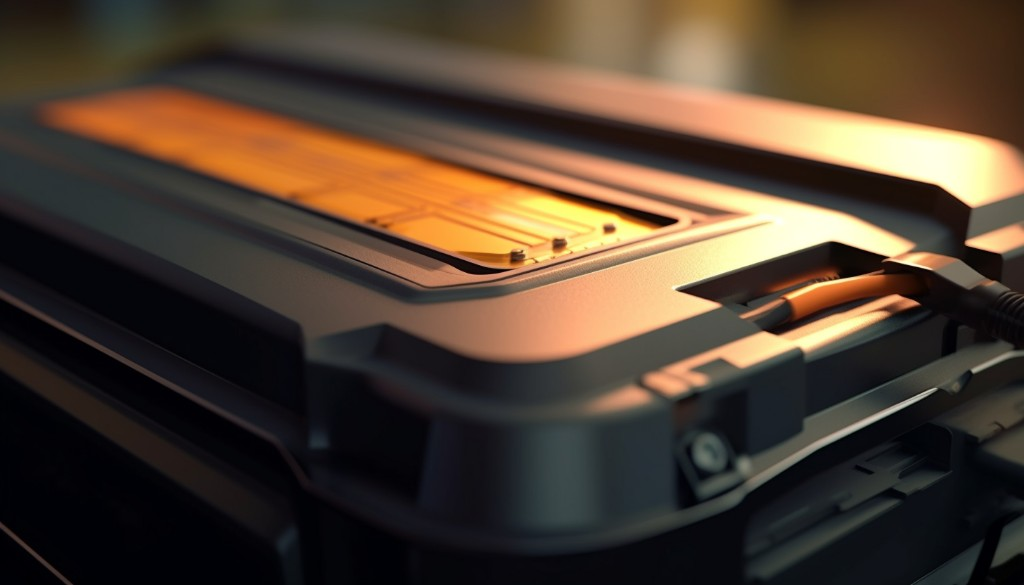
Decoding Battery Specifications
Understanding your skateboard’s battery specifications is crucial to ensure optimal performance and longevity.
Understanding Voltage
Voltage, in simple terms, can be thought of as the ‘pressure’ that pushes the electric current through your skateboard’s circuit. Higher voltage often equates to higher top speed. However, keep an eye out for ‘voltage sag,’ a common issue where the board’s performance drops as the battery drains. Too much voltage sag can turn a thrilling ride into a sluggish crawl.
Interpreting Amp Hours (AH)
Amp Hours (AH) are a measure of battery capacity. The higher the Amp Hour rating, the longer your electric skateboard will run on a single charge. It’s like the size of your skateboard’s fuel tank.
Calculating Watt Hours (Wh)
Watt Hours (Wh) is a measure of the total energy stored in a battery. You can calculate it by multiplying the voltage (V) by the Amp Hours (AH). Understanding Watt Hours can give you a clear idea of your skateboard’s potential range or battery life.
Battery Maintenance Best Practices
Ensuring your electric skateboard battery’s health isn’t rocket science. Simple practices like avoiding overcharging, keeping the battery at moderate temperatures, and storing it at 50% charge when not in use for long periods can significantly extend your battery’s lifespan.
Common Battery-Related Issues
Like any piece of technology, electric skateboard batteries aren’t immune to issues. Some common problems include reduced range over time, sudden power loss, and swelling of the battery pack. Many of these issues can be mitigated with proper care and maintenance. If problems persist, consult with a professional or your skateboard manufacturer to avoid safety hazards.
Getting a grip on these basics can set you on the path to becoming an informed e-skateboard owner, ready to tackle battery issues head-on and make the best choice when it comes to powering your ride. Remember, knowledge is power – and in this case, literally so!
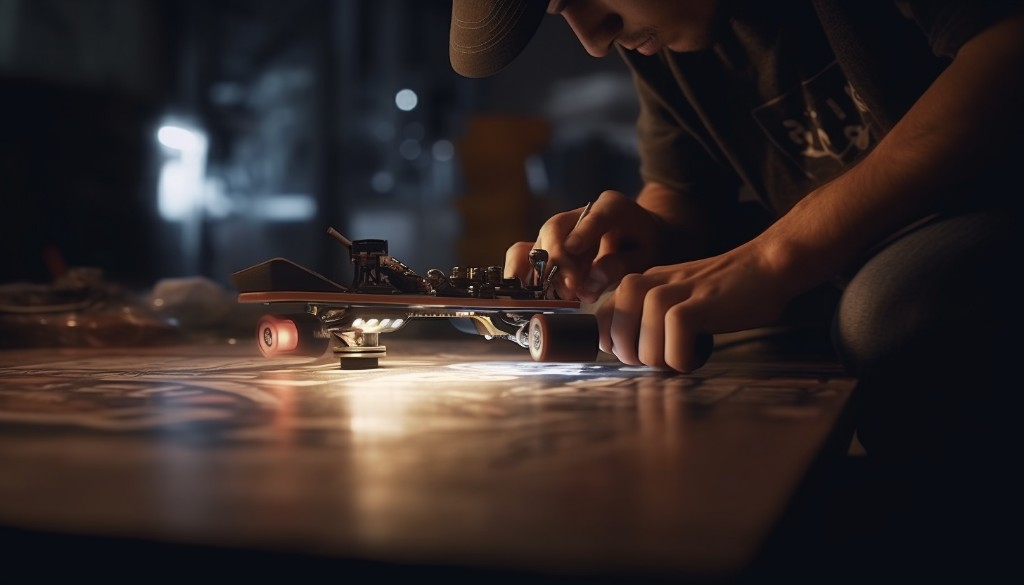
How to Choose the Right Battery for Your Electric Skateboard
Selecting the right battery for your electric skateboard is more than just picking one off the shelf. It requires a careful examination of several factors to ensure you’re making the most out of your e-skateboard experience.
Assessing Battery Quality
As with any other product, the quality of your electric skateboard battery can greatly affect its performance and longevity. It’s like choosing a heart for your board – a high-quality one can keep it running smoothly for a long time, while a poor one might lead to frequent breakdowns and short-lived joy rides.
One way to gauge battery quality is by considering the reputation of the brand. Established brands are often more reliable as they have proven track records and have invested significantly in research and development. You wouldn’t want to risk your ride on a no-name battery that hasn’t been thoroughly tested, would you?
Another method to assess quality is by looking at user reviews. Real-life experiences from fellow skateboarders can provide valuable insights into the battery’s performance, durability, and potential issues. It’s like getting a sneak peek into how the battery might perform on your own board.
Lastly, certifications can also indicate quality. Batteries that have passed rigorous testing and meet safety standards are generally more trustworthy. So, if you see any certifications listed on the battery pack, take it as a good sign!
Evaluating Battery Range
The range of your skateboard battery pack is another crucial aspect to consider. It determines how far your electric skateboard can travel on a single charge. Just like how you wouldn’t buy a car without knowing its gas mileage, you should be well-informed about your e-skateboard’s range.
To evaluate the battery range, you can start by looking at the manufacturer’s specifications. They usually provide an estimated range based on standard testing conditions. However, keep in mind that the actual skateboard range can vary depending on several factors such as your weight, riding style, terrain, and even weather conditions.
User reviews can again be a useful resource to get a realistic idea of the battery life. Riders often share their experiences about the actual range they achieved during their rides. This can help you gauge if the battery can meet your travel needs or not.
Considering Battery Type
Finally, the type of battery you choose for your electric skateboard can significantly impact its performance and convenience. It’s like choosing between different types of fuel for a car – each has its own advantages and disadvantages.
There are mainly two types of batteries used in electric skateboards: Lithium-ion (Li-ion) and Lithium Polymer (LiPo). Li-ion batteries are generally more stable and have a longer lifespan, but they might not deliver the same power output as LiPo batteries. On the other hand, LiPo batteries can provide higher performance but require more careful handling and maintenance.
The choice between these battery types depends largely on your individual needs and skateboard specifications. If you value stability and longevity, Li-ion might be your go-to option. But if performance is your top priority, you might want to consider LiPo.
Remember, there’s no one-size-fits-all solution when it comes to choosing a skateboard battery. What works best for one rider might not necessarily be the best for you. So, take your time to evaluate all these factors before making your decision.
Choosing the right battery for your electric skateboard is indeed a thoughtful process but trust me, it’s worth every bit of your effort. After all, a well-chosen battery is key to enjoying an uninterrupted and thrilling ride on your e-skateboard.
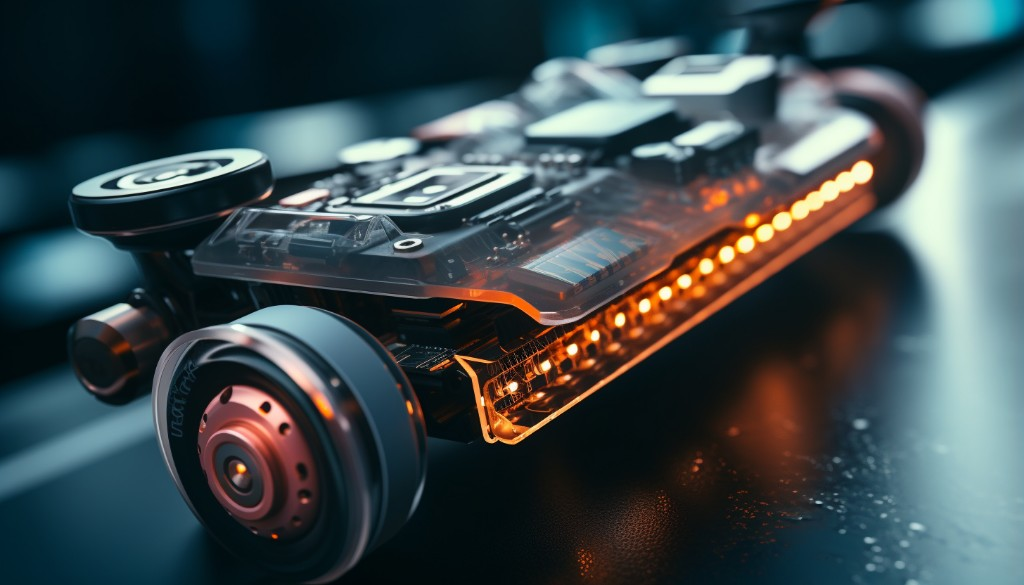
Detailed Analysis of Electric Skateboard Battery Types
When it comes to powering your electric skateboard, the choice of battery can significantly impact your ride. The three most commonly used types are Lithium-Ion, Lithium Polymer, and Lithium Iron Phosphate batteries. Let’s dive into each one and examine their pros and cons.
Advantages and Disadvantages of Lithium-Ion Batteries
Starting with Lithium-Ion batteries, commonly known as li-ion batteries, these powerhouses have become popular in many portable electronic devices, including e-skateboards. Li-ion batteries are generally lightweight and compact, making them an excellent choice for e-skateboards where weight and size matter. They also boast a high energy density, meaning they can store more energy in a smaller space than other battery types.
Moreover, li-ion batteries have a low self-discharge rate, so even if you aren’t using your board for a while, the battery won’t drain as quickly. This makes it an ideal skateboard battery for those who don’t use their boards daily.
However, they are not without their drawbacks. The most significant disadvantage of li-ion batteries is their lifespan. They typically last for around 300 to 500 charge cycles before their performance starts to degrade. This means if you’re using your electric skateboard daily, you might need to replace the battery within a couple of years.
Additionally, li-ion batteries can be susceptible to overheating, which can lead to performance issues or even safety risks if not monitored closely. Therefore, they require a built-in protection circuit to prevent overcharging and overheating.
Pros and Cons of Lithium Polymer Batteries
Next up are Lithium Polymer batteries. These batteries offer a few advantages over their li-ion counterparts. For starters, they are more lightweight and flexible, allowing for more design freedom. This means that they can be shaped to fit into various electric skateboard designs without adding excessive weight or bulk.
Another significant advantage of Lithium Polymer batteries is their ability to deliver a higher discharge rate. This means they can provide more power when needed, making them perfect for high-performance electric skateboards that require quick acceleration and high top speeds.
On the flip side, Lithium Polymer batteries do come with their set of drawbacks. Like li-ion batteries, they have a limited lifespan, typically around 300 to 500 charge cycles. Moreover, they are more prone to damage if punctured or mishandled, which can lead to safety concerns. Also, they have a higher self-discharge rate than li-ion batteries, so they may not be the best choice if you don’t use your skateboard regularly.
Benefits and Drawbacks of Lithium Iron Phosphate Batteries
Lastly, we have Lithium Iron Phosphate batteries. These batteries are often lauded for their long lifespan, with some lasting up to 2000 charge cycles. This makes them an excellent choice for those who use their electric skateboards frequently and want to avoid the hassle and cost of frequent battery replacements.
Another advantage of these batteries is their safety. Lithium Iron Phosphate batteries are more stable and less likely to overheat or catch fire compared to li-ion or Lithium Polymer batteries.
However, they also come with a few downsides. The most noticeable one is their size and weight. Lithium Iron Phosphate batteries are typically larger and heavier than other lithium battery types, which can add to the overall weight of the electric skateboard and potentially impact its portability and performance.
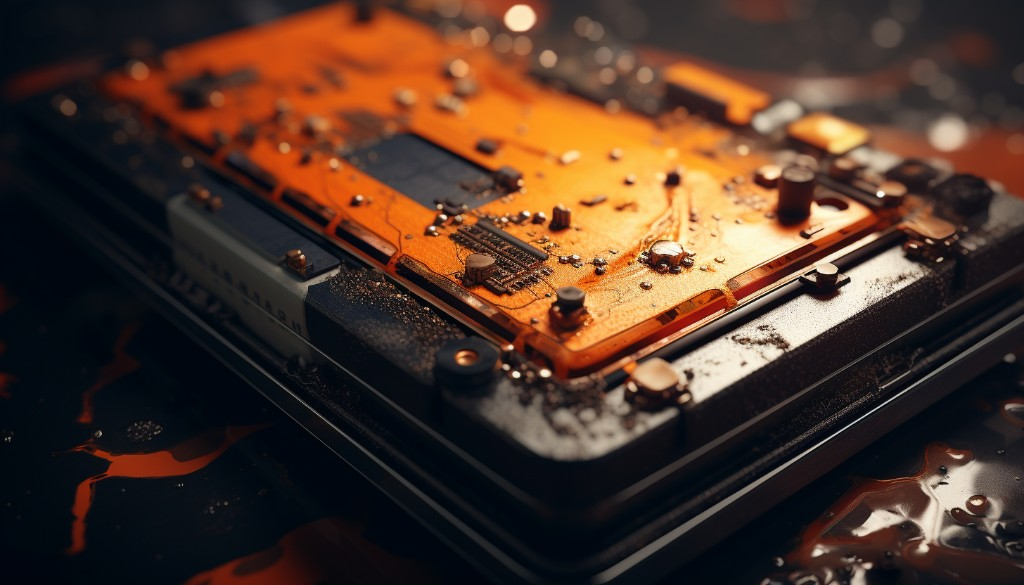
Furthermore, they have a lower energy density than other lithium batteries, meaning they might not hold as much charge. This could result in a shorter range for your electric skateboard, which could be a deal-breaker if you use your board for long commutes.
When choosing a battery for your electric skateboard, it’s essential to consider your specific needs and how each battery type might meet them. Whether it’s the lightweight and high energy density of li-ion batteries, the high discharge rate of Lithium Polymer batteries, or the long lifespan and safety of Lithium Iron Phosphate batteries, each option offers its unique advantages and drawbacks. The choice, as they say, is in your hands.
Essential Tips for Extending Electric Skateboard Battery Life
As an avid e-skateboard rider, I’ve found that taking good care of your battery can significantly enhance its lifespan. So, I’ll share some essential tips that have helped me prolong the life of my electric skateboard battery.
Avoiding Extreme Temperatures
The performance and life of an electric skateboard battery can be severely affected by extreme temperatures. Batteries tend to lose capacity in extreme cold and may overheat in intense heat, both of which can shorten their lifespan.
For instance, during my winter rides, I noticed a slight decrease in my board’s range. The battery capacity seemed to drop faster than usual due to the cold temperature. To prevent this, consider storing your e-skateboard in a temperature-controlled environment whenever possible. When riding in cold weather, try to keep the board indoors until you’re ready to ride.
Regular Riding and Battery Longevity
Contrary to what you might think, regular riding can actually help enhance your battery life. When I started using my board daily, I noticed an improvement in the battery’s performance.
This happens because regular use helps keep the battery active, preventing it from going into a deep sleep mode that can make it harder to recharge. It’s similar to how regular exercise keeps our muscles toned and our bodies healthy – your battery needs its own form of ‘exercise’ too!

Preventing Battery Depletion
One of the most crucial tips I’ve learned is never to let your electric skateboard battery completely deplete. Draining the battery to zero can cause what’s known as deep discharge, which significantly shortens the battery life.
To prevent this, always try to recharge your board when it reaches around 20% battery level. I’ve made it a habit to plug in my board for charging as soon as I finish my ride. This simple practice has helped me maintain my battery’s health and extend its life significantly.
The Importance of Regular Battery Check and Cleaning
Regular battery maintenance is another key factor in prolonging the life of your electric skateboard battery. Just like you’d regularly check your car’s engine oil or tire pressure, you should also make regular checks and clean your e-skateboard’s battery.
I usually check my battery every few weeks for any signs of damage or wear. If I spot any dirt or dust, I carefully clean it off to prevent any potential damage. Regular checks and cleaning can help you spot any issues early on and maintain optimal battery performance.
By following these tips, you can maximize your battery life and enjoy longer, smoother rides on your electric skateboard. Remember, good battery maintenance can not only extend the life of your battery but also enhance your riding experience.
Just as the health of the engine affects a car’s performance, the condition of the battery affects an e-skateboard’s performance. So take good care of it, and it will take care of you on the roads!
Battery Charging Basics for Electric Skateboards
Let’s dive into the heart of the matter: charging your electric skateboard. It might seem straightforward, but there are a few essential points to keep in mind when you plug in your ride. If you’re like me, you’ve probably found yourself eager to hit the pavement and cruise on your e-skateboard, only to discover your battery is running on fumes. It’s a frustrating situation that leaves you scrambling to charge the battery.

Optimal Charging Practices
Charging an electric skateboard battery isn’t as simple as plugging it in and walking away. It’s essential to monitor the charging process closely to ensure optimal performance and longevity of your skateboard battery pack. Here are a few pointers I’ve picked up along the way:
- Always use the charger provided by the manufacturer. This charger is specifically designed for your skateboard’s battery and ensures safe and efficient charging.
- Charge the battery at room temperature. Extreme temperatures, either hot or cold, can damage the battery and decrease its lifespan.
- Avoid charging the battery immediately after a ride. Allow it to cool down first to prevent overheating.
Understanding Overcharging Risks
Overcharging is a common mistake that can lead to serious problems. When a battery is overcharged, it means it’s being fed more electricity than it can handle. This can cause the battery to overheat, which in turn can lead to decreased performance, damage, or even a fire.
Preventing overcharging is simple: keep an eye on your battery as it charges and unplug it once it’s fully charged. Most electric skateboards have an indicator light that changes color or turns off when the battery is full. If yours doesn’t, check the user manual for the recommended charging time and set a timer to remind yourself to unplug it.

Estimating Battery Recharge Time
Figuring out how long it will take to charge the battery is a bit of a guessing game unless you know your battery’s capacity and your charger’s output. The basic formula is: Battery Capacity (in watt-hours) divided by Charger Output (in watts) equals Charging Time (in hours).
For example, if you have a 250-watt-hour battery and a 50-watt charger, your charging time will be approximately five hours. Remember, this is an estimate; the actual time can vary depending on the battery’s age and condition.
Keep in mind, larger batteries or those with higher capacities will naturally take longer to charge. On the flip side, fast chargers can significantly reduce charging time, but they may also increase the risk of overcharging if not monitored closely.
So there you go, a quick primer on charging your electric skateboard battery. It’s a simple process, but one that requires attention to detail to keep your board running smoothly and safely. Now, let’s move on to understanding how different battery technologies impact your electric skateboarding experience.
The Impact of Battery Technology on Electric Skateboard
As an avid e-skateboard rider, I’ve noticed that advancements in battery technology have revolutionized electric skateboarding. The heart of any e-skateboard is undoubtedly its battery, and the advent of newer, more efficient batteries has drastically improved performance and range.

Previously, the most common type of battery used in electric skateboards was sealed lead-acid (SLA) batteries. However, they were bulky, heavy, and didn’t offer much range. With the progression of battery technology, lithium-ion and lithium-polymer batteries have become the norm for electric skateboards. These batteries are lighter, smaller, and can store a lot more energy compared to their predecessors.
A pivotal moment in the realm of battery technology was the introduction of lithium iron phosphate (LiFePO4) batteries. Known for their exceptional longevity and safety features, these batteries have become increasingly popular among e-skateboard enthusiasts. Their unique chemistry allows for a high number of charge cycles without significant degradation, making them an excellent choice for those looking to maximize their electric skateboard’s lifespan.
The Role of Battery Management Systems (BMS) in Electric Skateboards
Functionality of BMS
When it comes to maintaining the health and efficiency of your e-skateboard’s battery, a battery management system plays a crucial role. A BMS is essentially the brain of the battery pack. It regulates the charging and discharging processes to ensure that each cell in the battery pack is operating within its safe limits.
A BMS keeps track of vital parameters like voltage, current, and temperature. By continuously monitoring these factors, the battery management system ensures that the battery operates within its optimum range. This prevents damage to the cells from overcharging or discharging, thereby prolonging the battery’s lifespan and maintaining the performance of your electric skateboard.
Benefits of BMS in Battery Life Extension
The battery management system doesn’t just protect your battery; it also helps extend its life. By controlling the charging process, a BMS ensures that the cells in your battery pack are charged evenly. This process, known as cell balancing, prevents any individual cell from being overcharged, which could lead to premature wear and tear.
Furthermore, a BMS can also extend your battery life by preventing deep discharging. Draining a battery to a very low state of charge can significantly reduce its lifespan. However, a BMS will cut off the power when the battery reaches a specific low voltage, thereby preventing deep discharge and helping to extend your electric skateboard’s battery life.

A Brief Overview of Custom Electric Skateboard Batteries
For those seeking a more personalized ride, custom electric skateboard batteries are an exciting option. Custom batteries allow you to tailor your e-skateboard’s performance to your specific needs. For instance, you can opt for a larger battery if you need more range, or choose a smaller one if portability is your priority.
Custom skateboard batteries also give you the freedom to choose the type of cells used. You could go for high-capacity cells for longer rides or high-discharge cells if speed is your thing. By allowing you to customize these factors, custom batteries can significantly enhance your electric skateboard experience.
Moreover, building a custom battery for your e-skateboard can also be an enjoyable DIY project. It gives you an intimate understanding of your board’s inner workings and can be quite rewarding. But remember, always prioritize safety when handling batteries and electrical components.
As we delve further into the world of electric skateboarding, it becomes increasingly clear how pivotal the role of batteries is. Whether it’s the evolution of battery technology, the importance of battery management systems, or the potential of custom batteries, each facet contributes to shaping the e-skateboarding landscape.
Closing Thoughts
In conclusion, choosing the right battery for your electric skateboard is a critical decision that can impact the performance and longevity of your ride. Understanding the essential battery dynamics for electric skateboards, including the role of Battery Management Systems (BMS), is key to making an informed choice. Furthermore, it’s essential to know how to extend your electric skateboard battery life and adhere to the proper charging basics. The advancement of battery technology has significantly impacted electric skateboarding, offering riders more power, longer rides, and overall better performance. As we move forward, custom electric skateboard batteries could provide more tailored solutions, enhancing the skateboarding experience even more.
Frequently Asked Questions
What type of battery is best for an electric skateboard?
The best type of battery for an electric skateboard often depends on the rider’s needs. However, lithium-ion batteries are generally recommended due to their high energy density, long life span, and lightweight characteristics.
How do I extend the life of my electric skateboard battery?
To extend the life of your electric skateboard battery, avoid completely draining the battery before recharging it. Also, maintain it at a moderate temperature and avoid overcharging.
What are the dangers of overcharging an electric skateboard battery?
Overcharging an electric skateboard battery can lead to decreased battery life, overheating, and in severe cases, it can cause the battery to explode or catch fire.
How does a Battery Management System work in an electric skateboard?
A Battery Management System (BMS) in an electric skateboard monitors and manages the battery’s operation. It ensures the battery operates within its safe limits, protects it from damage, and extends its lifespan.
Are custom batteries better for electric skateboards?
Custom batteries can be better for electric skateboards as they can be designed to fit specific models perfectly, potentially offering better performance and longer lifespan. However, they can also be more expensive than standard batteries.
